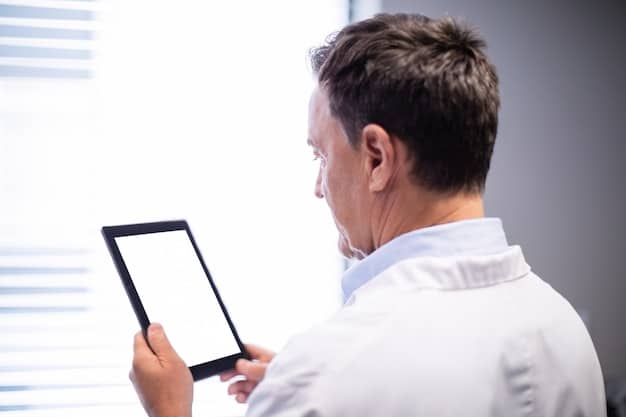US Healthcare Transformation: Future Tech Impacting Patient Outcomes

US Healthcare Transformation: How Future Tech is Improving Patient Outcomes explores innovations like AI, telehealth, and wearables are revolutionizing healthcare delivery, enhancing diagnostics, and personalizing treatments in the United States.
The US healthcare system is undergoing a significant transformation, driven by the rapid advancements in future technologies. These innovations promise to improve patient outcomes, increase efficiency, and reduce costs. This article delves into how future tech is reshaping healthcare in the US, exploring the key areas and their potential impact.
The Rise of Artificial Intelligence in US Healthcare
Artificial intelligence (AI) is rapidly changing the landscape of US healthcare. From diagnostics to treatment planning, AI is being used to improve accuracy, efficiency, and patient outcomes. Its ability to analyze vast amounts of data quickly and accurately makes it an invaluable tool for healthcare providers.
AI in Diagnostics
AI algorithms can analyze medical images, such as X-rays and MRIs, with greater speed and precision than human radiologists. This leads to earlier and more accurate diagnoses, improving patient outcomes and reducing the risk of misdiagnosis.
AI in Personalized Treatment
AI can analyze patient data to develop personalized treatment plans that are tailored to the individual’s specific needs. This approach can lead to more effective treatments and fewer side effects, ultimately improving the patient’s quality of life.
- Improved Accuracy: AI algorithms can detect subtle anomalies in medical images that might be missed by human eyes.
- Increased Efficiency: AI can automate routine tasks, freeing up healthcare professionals to focus on more complex cases.
- Personalized Care: AI can analyze patient data to tailor treatment plans to individual needs.
- Reduced Costs: By improving efficiency and reducing errors, AI can help lower healthcare costs.
In conclusion, the integration of AI into US healthcare is revolutionizing diagnostics, treatment planning, and patient care. As AI technology continues to advance, its potential to improve patient outcomes and transform the healthcare system will only grow.

Telehealth: Expanding Access to Care
Telehealth, the delivery of healthcare services remotely using technology, is becoming increasingly important in the US. It offers numerous benefits, including increased access to care, reduced costs, and improved patient convenience. Telehealth is particularly valuable for patients in rural areas or those with limited mobility.
Benefits of Telehealth
Telehealth allows patients to consult with doctors, receive prescriptions, and monitor their health from the comfort of their homes. It eliminates the need for travel, reducing costs and saving time. It is also a convenient option for patients who have difficulty leaving their homes.
Telehealth in Chronic Disease Management
Telehealth is particularly effective for managing chronic diseases such as diabetes and hypertension. Remote monitoring devices can track vital signs and alert healthcare providers to any changes, allowing for timely interventions and preventing complications.
- Increased Access: Telehealth expands access to care for patients in rural areas and those with limited mobility.
- Reduced Costs: Telehealth eliminates the need for travel and reduces the cost of in-person visits.
- Improved Convenience: Telehealth allows patients to receive care from the comfort of their homes.
- Better Disease Management: Remote monitoring devices can help manage chronic diseases more effectively.
In summary, telehealth is transforming the delivery of healthcare services in the US, expanding access to care, reducing costs, and improving patient convenience. As technology continues to evolve, telehealth will play an even greater role in the future of healthcare.
Wearable Technology: Monitoring and Empowering Patients
Wearable technology, such as smartwatches and fitness trackers, is playing an increasingly important role in US healthcare. These devices can continuously monitor vital signs, track physical activity, and provide patients with valuable insights into their health. This data can be used to improve patient engagement and personalize treatment plans.
The Role of Wearables in Preventive Care
Wearable devices can track various health metrics, such as heart rate, sleep patterns, and activity levels. This data can be used to identify potential health risks early on and encourage patients to adopt healthier lifestyles.
Wearables in Post-Surgical Monitoring
Wearable technology can be used to monitor patients after surgery, tracking their recovery progress and detecting any complications. This allows healthcare providers to intervene quickly and prevent serious health issues.
- Continuous Monitoring: Wearable devices provide continuous monitoring of vital signs and activity levels.
- Early Detection: Wearables can detect potential health risks early on, allowing for timely interventions.
- Improved Engagement: Wearables empower patients to take control of their health by providing them with valuable insights.
- Personalized Treatment: Wearable data can be used to personalize treatment plans and improve patient outcomes.
In conclusion, wearable technology is revolutionizing patient monitoring and empowering individuals to take greater control of their health. As wearable devices become more sophisticated and affordable, their impact on US healthcare will continue to grow.

3D Printing: Revolutionizing Medical Devices and Implants
3D printing, also known as additive manufacturing, is transforming the medical device and implant industries in the US. This technology allows for the creation of customized devices and implants that are tailored to the individual patient’s anatomy, improving outcomes and reducing complications.
Customized Implants with 3D Printing
3D printing enables the creation of customized implants for bone and joint replacements, dental restorations, and other medical applications. These implants fit perfectly into the patient’s body, improving function and reducing the risk of rejection.
3D-Printed Prosthetics
3D printing is also being used to create affordable and customized prosthetics for amputees. These prosthetics can be designed to meet the individual’s specific needs and preferences, improving their quality of life.
- Customization: 3D printing allows for the creation of customized devices and implants that are tailored to the individual patient’s anatomy.
- Improved Outcomes: Customized implants fit perfectly into the patient’s body, improving function and reducing the risk of rejection.
- Cost-Effectiveness: 3D printing can reduce the cost of manufacturing medical devices and implants.
- Faster Production: 3D printing enables faster production of medical devices and implants.
In summary, 3D printing is revolutionizing the medical device and implant industries in the US, enabling the creation of customized, cost-effective, and high-quality solutions for patients. As 3D printing technology becomes more advanced, its impact on healthcare will continue to grow.
Blockchain Technology: Enhancing Data Security and Interoperability
Blockchain technology is emerging as a promising solution for enhancing data security and interoperability in US healthcare. Blockchain is a decentralized, immutable ledger that can be used to securely store and share patient data. This can improve data integrity, reduce fraud, and facilitate the secure exchange of information between healthcare providers.
Securing Patient Data with Blockchain
Blockchain can be used to secure patient data by creating a permanent, tamper-proof record of all transactions. This makes it more difficult for hackers to access and alter sensitive information.
Improving Interoperability with Blockchain
Blockchain can facilitate the secure exchange of patient data between different healthcare providers, improving interoperability and enabling more coordinated care. This can lead to better patient outcomes and reduced costs.
- Enhanced Security: Blockchain creates a permanent, tamper-proof record of all transactions, making it more difficult for hackers to access and alter sensitive information.
- Improved Interoperability: Blockchain facilitates the secure exchange of patient data between different healthcare providers.
- Reduced Fraud: Blockchain can help reduce fraud by creating a transparent and auditable record of all transactions.
- Increased Efficiency: Blockchain can automate many administrative tasks, improving efficiency and reducing costs.
In conclusion, blockchain technology has the potential to significantly improve data security and interoperability in US healthcare. As blockchain adoption increases, its impact on the healthcare system will become even more profound.
The Internet of Things (IoT) in Healthcare
The Internet of Things (IoT) is transforming US healthcare by connecting medical devices, sensors, and other healthcare-related equipment to the internet. This allows for the collection and analysis of real-time data, improving patient monitoring, treatment planning, and overall healthcare delivery.
Remote Patient Monitoring with IoT
IoT devices can be used to remotely monitor patients’ vital signs, medication adherence, and other health metrics. This allows healthcare providers to track patients’ progress and intervene quickly if any problems arise.
Smart Hospitals and IoT
IoT technology is also being used to create smart hospitals that are more efficient, safe, and patient-centered. Smart hospitals utilize IoT devices to automate tasks, track equipment, and improve patient flow.
- Improved Monitoring: IoT devices enable remote patient monitoring, allowing healthcare providers to track patients’ progress and intervene quickly if any problems arise.
- Increased Efficiency: IoT technology can automate many tasks in hospitals, improving efficiency and reducing costs.
- Enhanced Safety: IoT devices can track equipment and monitor environmental conditions in hospitals, improving safety and reducing the risk of infections.
- Better Patient Experience: Smart hospitals can provide a more patient-centered experience by automating tasks and improving communication.
In summary, the Internet of Things is revolutionizing US healthcare by connecting medical devices and equipment to the internet, enabling remote patient monitoring, smart hospitals, and improved healthcare delivery. As IoT technology continues to advance, its impact on the healthcare system will only grow.
| Key Point | Brief Description |
|---|---|
| 🤖 AI in Healthcare | AI improves diagnostics, personalizes treatments and increases efficiency. |
| 📱 Telehealth Expansion | Telehealth enhances access to care, especially for rural and remote patients. |
| ⌚ Wearable Technology | Wearables monitor vitals and empower patients in preventive care. |
| 🛡️ Blockchain Security | Blockchain secures data, improves interoperability, and reduces fraud. |
Frequently Asked Questions
▼
AI algorithms analyze medical images such as X-rays and MRIs, increasing diagnostic accuracy and speed, which leads to earlier and more effective treatments and improved patient outcomes.
▼
Telehealth provides convenient access to healthcare from home, reducing the need for travel, lowering costs, and facilitating remote monitoring for chronic conditions, enhancing overall patient experience.
▼
Wearable devices continuously monitor vital signs and activity levels, identifying potential health risks early and encouraging healthier lifestyles by providing users with valuable health insights and personalized feedback.
▼
3D printing enables the creation of customized implants tailored to individual patient anatomy, that improving function, reduces the risk of rejection, and delivers better outcomes compared to standard implants.
▼
Blockchain secures patient data by creating a tamper-proof record of all transactions, making databreaches or unauthorized alterations much more challenging, and thereby enhancing patient data integrity and confidentiality.
Conclusion
The **US Healthcare Transformation: How Future Tech is Improving Patient Outcomes** discussed in this article highlights the vast potential of future technologies to revolutionize healthcare delivery, enhance diagnostics, personalize treatments, and improve patient outcomes. As these technologies continue to evolve and become more integrated into the healthcare system, their impact will undoubtedly transform healthcare in the US, benefiting healthcare providers and patients alike.





